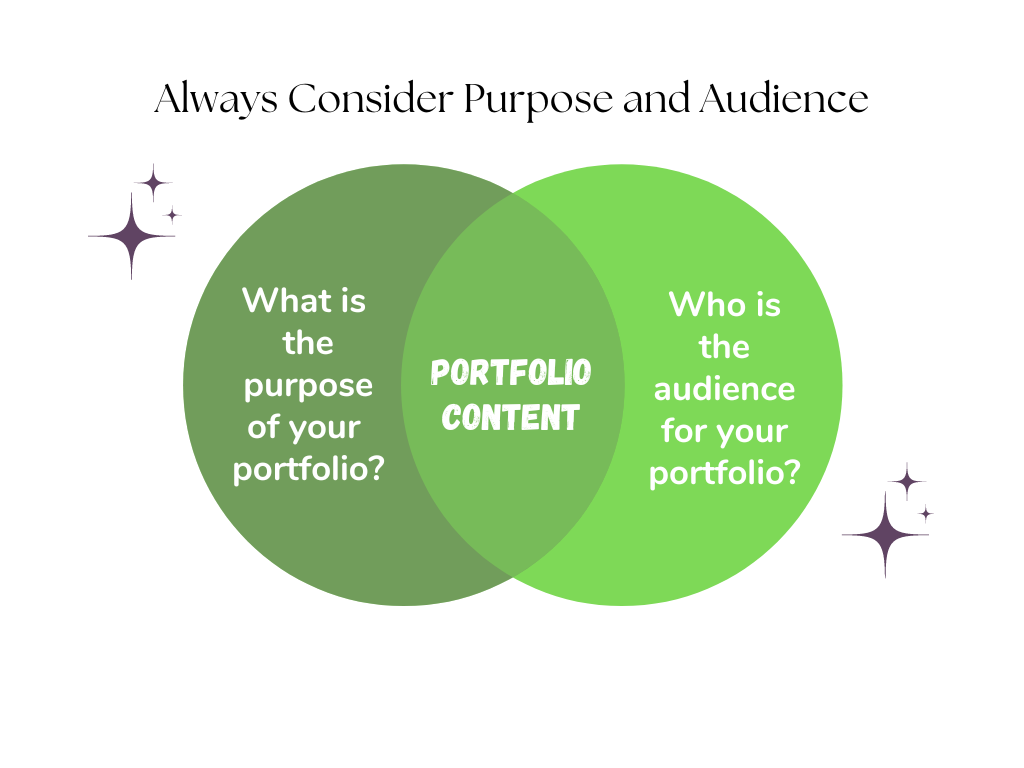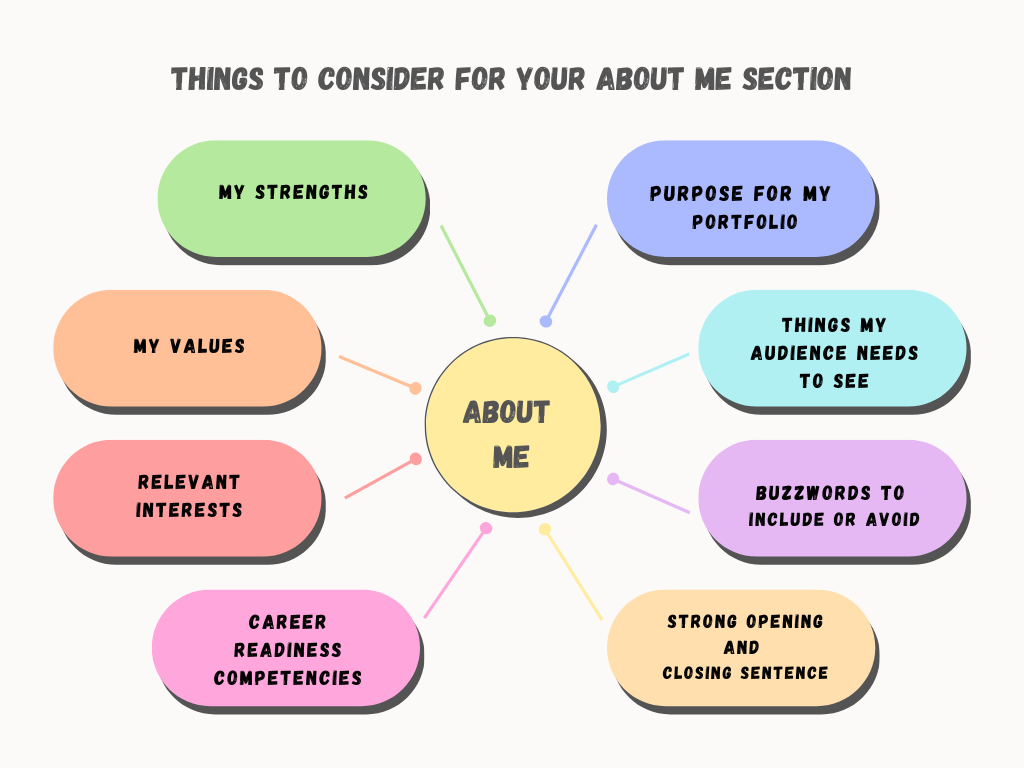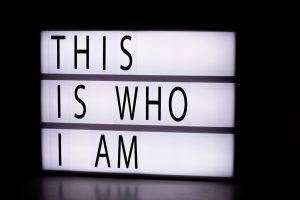3 Crafting Your About Me Statement
Lynn Meade
“You never get a second chance to make a first impression” and this section is your opportunity to form that first impression. This short introduction tells your audience a little bit about you, and it sets the tone for the rest of your portfolio. This chapter will help you to adapt your statement to your audience and purpose. In addition, there will be brainstorming activities to help you craft an about-me statement that is right for you.
What is an About Me Page?
According to Dr. Angela Williams, former Career Center Executive Director and Teaching Assistant Professor, “The about me page is an opportunity for you to describe more about you and highlight the connections between your skills, experiences, and knowledge. Consider including your major, interests, or future plans. What future challenges do you plan to work on? What motivates you? What background details about yourself do you want your professors, employers, or other possible visitors to know? Make sure your biographical information is relevant and professional. The about me page could also feature your personal brand or message and can include a professional photo and even fun videos and photos or whatever you think represents you and other relevant hobbies, skills and experiences.”
Think of These Things First
As you begin to write your about me statement, you need to ask yourself, “Why am I writing this” and “Who do I want to read it?” Defining your audience and purpose will help you craft your about statement in a way that best tells your story.
What is the Purpose of Your Portfolio?

The About Me is where your story begins. Much like the opening scene of a movie where you meet the character for the first time, your About Me Page allows the reader to begin to see who you are. You are not telling everything about you, rather you are telling them the things that help you get closer to your goals. Your About Me should include things about your purpose and write about your potential audience.
Jeremy Zimmett, has graduated and is seeking a career in data librarianship, in his About Me statement, he makes his purpose and his passion clear.
For me, pursuing a career in data librarianship is a call to action. It is a call to engineer technologies and ideas that will dismantle the barriers that separate us from one another. It is a call to build a better bridge between people and information. It is a call to build community through the act of reading, togetherness, and access to resources. With drastic changes occurring in government and the economy every day, it’s clear that the time to act is now—and we can’t waste any of it.
Emmira Harris is a Junior Civil Engineering major and writes this on her About Me Page:
I am currently an Undergraduate Research Assistant for Dr. Sarah Hernandez, a transportation civil engineering professor in the College of Engineering. Education and STEM are two of my passions, so through the years I’ve had to figure out how to incorporate these passions in the development of my future. I have goals that align with both, and I plan to fulfill them through my life’s journey.
Hunter Anderson, a Senior Music Major writes about the intersection between his passion and his major:
I’m Hunter, a driven and compassionate musician who has been studying, teaching, and performing the guitar for most of my life. Currently, I’m a senior at the University of Arkansas with a major in Guitar Performance. Post-graduation, I strive to teach and inspire others through lessons, performances, compositions, and to continuously ignite my passion for music.
Exercise: Brainstorm Your Purpose
Spend two minutes writing on each of these prompts to help you brainstorm your purpose.
- Where do you see yourself in one to three years?
- How does the work that you want to do fit into the world you want to live in?
- What is a story about you that shows your character?
- What kinds of creative endeavors or projects interest you?
- How have you grown as a person in the last few years?
Who is the Audience for Your Portfolio?
You are making your portfolio for a particular audience–a professor, a program director, a graduate school committee, or a future employer. To get into the mind of your audience, write out the answers to these questions and keep these answers in front of you whenever you work on your portfolio.
-
- What are your professional goals?
- Who can help you reach those goals?
- What things are important to that person/people?
- What skills, experience, and knowledge are they looking for in a candidate?
- What motivates them?
- What phrases or terms would appeal to them?
What Buzzwords Should You Include or Exclude?
Once you determine your purpose and your audience, you need to decide if that is a narrow or wide audience. If you are writing to a graduate school in a particular field, that is a very narrow audience and you will want to use insider language. They will be looking for certain words that demonstrate your knowledge. If this is the case, make a list of insider words that they expect to see. If you are making your portfolio for a variety of different employers, you will want to minimize specialty language and explain any necessary insider terms that you decide to use.
What is the Level of Your Audience’s Understanding?
While we are talking about audience and purpose, it is important to think about the knowledge level of your portfolio audience. For example, in my early career, I interviewed with a board of directors made up of physicians and social workers. They wanted to hire me to be a fundraiser, volunteer coordinator, and a media director for a not-for-profit. As a newly minted master’s graduate, I might be tempted to reference the Elaboration Likelihood Model and Judgemental Heuristics and how I built my projects using those as foundations. It is unlikely that my interviewers would understand. They would, however, understand that I studied persuasive theory and how it applied to the way people make decisions. They would understand that I worked on projects where I used persuasive theory to get concrete results. They would especially understand a story about a project that I worked on and the results that I got.
When we work closely with things for a long time, we don’t even realize that we speak in “code.” Alan Alda realized that the more people know, the harder it is for them to talk to others; he called this the “curse of knowledge.” In his book, If I Understood You, Would I Have This Look on my Face? he wrote, “Once we know something, it’s hard to unknow it, to remember what it’s like to be a beginner. It keeps us from considering the listener. Using shorthand that is incomprehensible to the other person, or referring to a process they’re unfamiliar with, we lock them out, and we don’t even realize it because we can’t believe we are the only person who knows this stuff.”

Thinking About Who You Are
When crafting your about me statement, it can be helpful to take a deep dive into who you are and what you value. After all, how can you tell someone who you are if you don’t know yourself?
I want you to think about your identity. Who are you? If I were to ask your parents who you are and then ask your best friend, I might get different answers. One might see you as outgoing and confident and the other might see you as unsure about yourself. Different people know different versions of you. In short, you have different identities. Most of us never really take the time to think about the many different ways we live out those different identities. When faced with building a portfolio, most students find they have never really thought about all the different identities they bring to the world and how to align those. For your portfolio, you are building your professional identity and you are highlighting your strengths, and talking about your experiences in a way that will be meaningful to employers or graduate programs.
To get started, you need to brainstorm your strengths. There is a chapter dedicated to helping you with this. Engaging in assessments, employing brainstorming frameworks, or seeking input from trusted friends and family can all prove instrumental. Once you have a list of your strengths, you can use those to start crafting your about me statement. Take a look at these examples and notice how each person highlights their strengths.
I am a chronic puzzle-seeker and a lifelong learner. I unpack complicated problems by approaching each with the flexible process and attention it deserves. This means that I work with others to ask questions, find approaches and execute solutions…August Winfield Miller
I learned, at a very early age, the importance of a strong work ethic, diligence, organization, and ambition. Growing up on my family’s farm involved physical labor, a willingness to work, and an ability to keep a positive attitude in adverse working conditions. Patience Marsh
Throughout my life I have prided myself upon my ability to adapt. Moving around a lot as a child forced me to take charge of my situation and surroundings. I excel at improvisation as well as complex problem solving as a result of my childhood experience. Amanda Seidner
The trick is to talk about professional skills and examples while still showing your personality. Look at these two statements to see how they are professional and still highlight the person’s personality.
From a very young age, I was always the type of person who loved helping people and got satisfaction out of making a difference in someone’s else’s life. Abby Christie Personal Statement.
I’m a Photographer and Designer based in Edinburgh.
The photography approach to the work I create is very much simplistic but also cinematically inspired. I love what I do, and I adore the creative process; it is an addiction and can give never ending possibilities.
Highlight Career Competencies
As you are highlighting, your strengths, you should consider the types of things that employers are looking for and add those if they apply. The National Association of Colleges and Employers suggest that there are eight things that employers are looking for in college graduates that indicate career readiness. These are called career competencies. Showing evidence of these competencies throughout your portfolio can increase the chances that an employer will consider you. These are the types of skills that employers report that they are looking for in candidates.
- Career and Self Development
- Communication
- Critical Thinking
- Equity and Inclusion
- Leadership
- Professionalism
- Teamwork
- Technology
There is an chapter dedicated to help you write about your career competencies.

Example of Using Career Competencies in the About Me Statement
So far, we have talked about audience, purpose, buzzwords, and career competencies. Let’s take a look at an example so you can see what it looks like when it all comes together. Fawn Kurtzo was a student at the University of Arkansas and her About Me is an excellent example of highlighting career competencies and writing to a specific audience.
I am currently a junior at the University of Arkansas, “Home of the Razorbacks” located in Fayetteville. My hometown of Parthenon is located in the most rural, yet renowned, county in Arkansas. Newton County is home of America’s first national river, which visitors often refer to as “The Buffalo”. In 2003 equine enthusiasts along the Buffalo National River began calling upon me for farrier services as well as my ability to start a young colt. By 2006 my journey to learning communication skills was well underway, because training the horse is far from the hardest part in satisfying clientele. Having a specialized skill of horsemanship was the kick-start of my path to understanding communication skills. I became a teacher for owners seeking to understand my practices, which eventually led to conducting private lessons to young children, peers and even adults. Along with dedication in schoolwork, my demeanor and equine skills earned a full-ride scholarship to Stephens College in Columbia, Missouri to study Equine Science the year of 2008. Though the burning desire to pursue a well-rounded agricultural degree brought me back to my home state for the following sophomore year; within the next few months I had given volunteer seminars across the state of Arkansas, was commonly featured in the Horseman’s Round Up magazine and filmed once for RFD-TV’s Southern Tales and Trails series.
Fast forwarding to the present, my past decade as a professional in the equine realm taught me how imperative communication skills are, not only in horsemanship – but every facet of success. In conjunction with my collegiate studies, I feel prepared for any job task. Professors have shown me the ropes of: up-to-date software and technology, campaign marketing along with approaches and evaluation, leadership skills, conducting presentations, and created awareness of available resources throughout to maintain adaptability. By adding these skills to my pre-existent “hang till the hair slips” outlook, I am geared up and ready for the next occupational chapter in the book of life- wherever that may lead.
Audience: As you read her statement, you will notice that her target audience is people who specialize in horses. She uses insider words like “farrier services, ” “shown me the ropes” and “hang til the hair slips” which would appeal to that audience. If her audience included non-horse enthusiasts, she would have needed to exclude or define those terms.
Career Competencies: Fawn does an excellent job of highlighting her career competencies.
- Career and Self Development
- Along with dedication in schoolwork, my demeanor and equine skills earned a full-ride scholarship to Stephens College in Columbia, Missouri to study Equine Science the year of 2008.
- In conjunction with my collegiate studies, I feel prepared for any job task.
- Communication
- By 2006 my journey to learning communication skills was well underway, because training the horse is far from the hardest part in satisfying clientele.
- Having a specialized skill of horsemanship was the kick-start of my path to understanding communication skills.
- Fast forwarding to the present, my past decade as a professional in the equine realm taught me how imperative communication skills are, not only in horsemanship – but every facet of success.
- Critical Thinking
- I became a teacher for owners seeking to understand my practices, which eventually led to conducting private lessons to young children, peers and even adults.
- Equity and Inclusion
- I became a teacher for owners seeking to understand my practices, which eventually led to conducting private lessons to young children, peers and even adults.
- Leadership
- I became a teacher for owners seeking to understand my practices, which eventually led to conducting private lessons to young children, peers and even adults.
- Professors have shown me the ropes of: up-to-date software and technology, campaign marketing along with approaches and evaluation, leadership skills, conducting presentations, and created awareness of available resources throughout to maintain adaptability.
- Professionalism
- Fast forwarding to the present, my past decade as a professional in the equine realm taught me how imperative communication skills are, not only in horsemanship – but every facet of success.
- Technology
- Professors have shown me the ropes of: up-to-date software and technology, campaign marketing along with approaches and evaluation, leadership skills, conducting presentations, and created awareness of available resources throughout to maintain adaptability.
The First Sentence Should Hook the Audience
Starting your about me with “I’m a sophomore at the University of Arkansas” is not a very interesting way to start. Saying, “Welcome to my ePortfolio page! This is where I will display all college my work” is also not very interesting.
After you have written your about me statement, you should go back and just read the first sentence. Is it interesting? Does it make you want to read more? What is the emotional tone?
Look at these statements for examples of strong opening statements.
- “I am a chronic puzzle-seeker and a lifelong learner.”
- “I am an experienced Marketing and sales professional, working full time in the wine & spirits industry with a current focus on executing luxury spirits initiatives.”
- “As a child, I was interested in things that were rarely noticed; my goal was to be on the lookout for these magical, seemingly invisible things.” Sydney Maples
- “I’m Hunter, a driven and compassionate musician who has been studying, teaching, and performing the guitar for most of my life.” Hunter Anderson
Typically, you would have an engaging opening sentence (or two) followed by your thesis. Your thesis should make clear who you are and what you want.
The Thesis Should Be Clear
I’m John, a junior studying organizational psychology with minors in business and leadership studies. After graduation, I hope to attain a full-time job working in the field of human resources in a corporate setting. John Prescott
The Last Sentence Should Be Purposeful
- “Ultimately, I am inspired by what cannot be seen directly – it must be felt, realized, or understood. To me, that is where the beauty of science comes in, and as a lifelong science communicator, I hope to articulate that beauty to the best of my ability.” Sydney Maples
- “Instilling respect for the music of the past, building good techniques, and fostering communication skills is what I believe should be the heart of an aspiring guitarist. Hunter Anderson
- “The teaching assignment at Tarleton State and Penn State University gave me opportunities to evaluate my ability as a teacher, and I believe that I have the qualities and desire needed to become a respected researcher and instructor. I would like to play a significant role in contributing in the areas of international adult and extension education by identifying important researchable problems and raising both local and global issues through active involvement.” Roshan Nayak
The About Me as a Video
The About Me can also be done as a video. In a study of high school principals, 93% of principals said they would use the video in hiring practices. They felt like they gained insight into the person from their video and you could tell from the way they spoke that the person in the video had a passion for teaching. One principal said, “I think that the video really enhances the ePortfolio . . . I think that it is wonderful. It is a whole different way to connect with a person without that person being here.” This study was on teachers and the connection is an easy one to make. Depending on your audience and purpose, the video may be the right option for you.
It is important to know your audience because not all businesses want photos or videos.
With increasing pressure on businesses to provide equitable hiring practices,
some companies will not consider you as a candidate if you include photos or videos.

Let Doubt Drive You to Work Harder
If you are like me, the thought of writing an “about me” statement makes you feel inadequate and self-conscious. I want you to know that you are not alone. In fact, most people have trouble with this.
Maybe you have heard of the imposter syndrome. It is the idea that most of us go around feeling like others are more equipped than we are and that if people would just see into our minds then they would know how inadequate we feel. It might surprise you to know that, 70% of professionals report feeling like an imposter.
Just because you feel like an imposter doesn’t mean you are going to fail, quite the contrary. Tewkik, an Assistant Professor at MIT says, “Interestingly, to date, there’s no empirical quantitative evidence that impostor thoughts degrade performance.” In fact, the Yerkes-Dodson stress performance curve, “shows that a few nerves—up to a point—improve performance. It may be that having the right amount of impostor thoughts can provide just enough motivation to bring out your best work.”
So if you have self-doubt, let that motivate you to work longer, try harder, and use the many resources available to you.
Exercises: Evaluate These Welcome Pages
Pick three to five of these welcome pages and evaluate them using the following questions.
- Is the first sentence engaging? Does it hook the reader?
- Do they include their strengths?
- Do they highlight career competencies?
- Does it appear to fit their purpose?
- How are buzzwords used to include or exclude readers?
- Lea Jackson – Journalism and Public Communication
- Maggie Engler – Electrical Engineering
- Jacob Langsner Film and Law
- Christine Alibozek -Hospitality
- Brent Warr – Environmental Design
- Roshan Nayak – Agriculture and Extension Education
- Sydney Maples- Science Communication
- Robin Shattler – Marketing
- Jarelle Hooks – Social Work
- Baylee Brown – Law
- Cam Cavaliere – English Rhetoric
- Kristin Ramsey – Sociology and Criminal Justice
- Sam Beskind – Management Science and Engineering
- Carrie Natasha – Pre Medical
- Kristin Morgan- Sociology and Social Work
- Megan Diem- Marketing
- Annabelle Farrow – Human Development
- Kyndal Driver- Marketing
- Mitch Carter – Geography and Geoscience
- Carrie White – Biology
Closing
We all have many different identities and different people know different versions of us. Most of us never really take the time to think about the many different ways we live out those different identities and how we can shape our professional identity. Your portfolio is your chance to shape that identity.
Now that you have brainstormed ideas and thought about your audience and the purpose, it is time to get to writing. It won’t be perfect at first. Writing is a process. As you work through the rest of your portfolio, come back from time to time and revisit your About Me statement and see if you are telling a consistent story.
You really are unique and amazing. Let your portfolio give them a reason to want to get to know you more.
Key Takeaways
- Always write with your audience and purpose in mind.
- Let your purpose determine whether you want to include industry buzzwords.
- Highlight your strengths in your about me statement.
- Try to include career competencies in your about me.
- Make sure that your first sentence is interesting.
Exercises: Additional Activities and Resources for Teachers
In addition to the exercises in this chapter, teachers might want to do the following to help students prepare their About Me page.
- Have students write a self-eulogy of what they want to be remembered for as a warm-up to writing the About Me page.
- Have them pretend to be the person/employer/teacher who will read the portfolio and make a list of everything that the person thinks is important.
- Do the exercise in this chapter “evaluate these welcome pages.”
- Have students sit in groups and finish the sentence, “I feel like an imposter when…”
- Work in groups and write an about me of a fictitious student that includes examples of each of the career competencies.
- After students write their About Me, have them run it through a word cloud generator and see what dominant words emerge. Discuss if that is the intended impression.
- Give them a page of thesis statements and have them evaluate them.
- Have students take the strengths and/or values assessment and then discuss in groups these questions: What about your strength sets you apart? Can you give an example of how you have demonstrated your strength in a way that might interest a future employer?
- Watch Good Communication 101: Mirroring, Jargon, Hifalutin Words by Alan Alda and talk about specialized language and how it can help and hinder communication. Discuss times that someone talked in a way that you didn’t understand. Reflect on your own writing and how you might use words that will make it difficult for your reader to connect with what you know.
- Watch Sharing Science Through Story by Fergus McAuliffe and discuss the importance of using audience-appropriate language.
Exercises: Try a Six Word Story
Try writing your story in six words. This can be a brainstorming activity or it can be included in the portfolio.
Fourth-year medical students were asked to write three six-word stories exploring their reasons for pursuing a career in medicine.
Unknown world of the deepest connections.
Feet grounded, mind sharp, heart fulfilled.
Preserving dignity throughout life, into death.
-Tori Ehrhardt
At the end, everyone is vulnerable.
Listening to people. Learning new perspectives.
Loud monitors. Your lullaby. Rest peacefully.
–Larissa Andrade
University of Arkansas Students Talk About Their Portfolios
References
Alda, A. (2017). If I understood you, would I have this look on my face? Random House.
Alda, A. (2017) Good Communication 101: Mirroring, Jargon, Hifalutin Words. BigThink.
Bird, S. (2007). Sensemaking and Identity: The Interconnection of Storytelling and Networking in a Women’s Group of a Large Corporation. The Journal of Business Communication (1973), 44(4), 311-339. https://doi.org/10.1177/0021943607306135
Casciaro, T., Gino, F., & Kouchaki, M. (2014). The Contaminating Effects of Building Instrumental Ties: How Networking Can Make Us Feel Dirty. Administrative Science Quarterly, 59(4), 705–735. https://doi.org/10.1177/0001839214554990
Creative Cloud. How to write an about me page that gets you hired. https://creativecloud.adobe.com/discover/article/how-to-write-an-about-me-page-that-gets-you-hired
Curl, R. Suffering from Imposter Syndrome? The Cure May Be Growth Mindset. Neuroleadership Institute. https://neuroleadership.com/your-brain-at-work/imposter-syndrome-cure-growth-mindset/
Format Team (December 2022). 7 Steps for Writing Your Portfolio’s Biography ‘About Me’ Page. https://www.format.com/magazine/resources/photography/online-portfolio-about-page-step-by-step-guide
Gallagher, C., & Poklop, L. (2014). ePortfolios and Audience: Teaching a Critical Twenty-First Century Skill. International Journal of EPortfolio, 4(1), 7–20. http://www.theijep.com/pdf/IJEP126.pdf
How to write an “About Me” page that gets you hired. Adobe Creative Cloud. https://creativecloud.adobe.com/discover/article/how-to-write-an-about-me-page-that-gets-you-hired
Harrell, E. (2022) Impostor Syndrome Has Its Advantages. Harvard Business Review. https://hbr.org/2022/05/impostor-syndrome-has-its-advantages
Hartwick, J. M.M. & Mason, R.W. (2014). Using Introductory Videos to Enhance ePortfolios and to Make Them Useful in the Hiring Process International Journal of ePortfolio. https://files.eric.ed.gov/fulltext/EJ1107853.pdf
Khan, S. Identity Development as Curriculum: A Metacognitive Approach in Yancy, K.B. (ed). (2019). ePortfolio as Curriculum: Models and Practices for Developing Students’ ePortfolio Literacy. Stylus Publishing.
Melles, B., Leger, A. B., & Covell, L. (2018). “Tell Me About Yourself” – Using ePortfolio as a Tool to Integrate Learning and Position Students for Employment, a Case from the Queen’s University Master of Public Health Program. The Canadian Journal for the Scholarship of Teaching and Learning, 9 (3). https://ir.lib.uwo.ca/cjsotl_rcacea/vol9/iss3/9
McAuliffe, F. (2013). Sharing Science Through Story. TedXDublin.
National Association of Colleges and Employers. What is Career Readiness? https://www.naceweb.org/career-readiness/competencies/career-readiness-defined/
Reynolds, N. & Davis, N. (2014). Portfolio keeping: A guide for students. Bedford St. Martin.
Stuart, H. (2019) Know your audience ePortfolio. Auburn Writing Center. https://auburn.app.box.com/s/4hylrfb25tp39mixtv49hwkqooz5e2k5
Stumbar SE, Phan M, Gomez DF, et al. Six-Word Stories Offer a New Opportunity for Medical Students’ Reflection. PRiMER. 2022;6:8. https://doi.org/10.22454/PRiMER.2022.644399
Singer-Freeman, Karen & Bastone, Linda. (2017). Changing Their Mindsets: ePortfolios Encourage Application of Concepts to the Self. International Journal of Finance & Economics. 7. 151-160.



